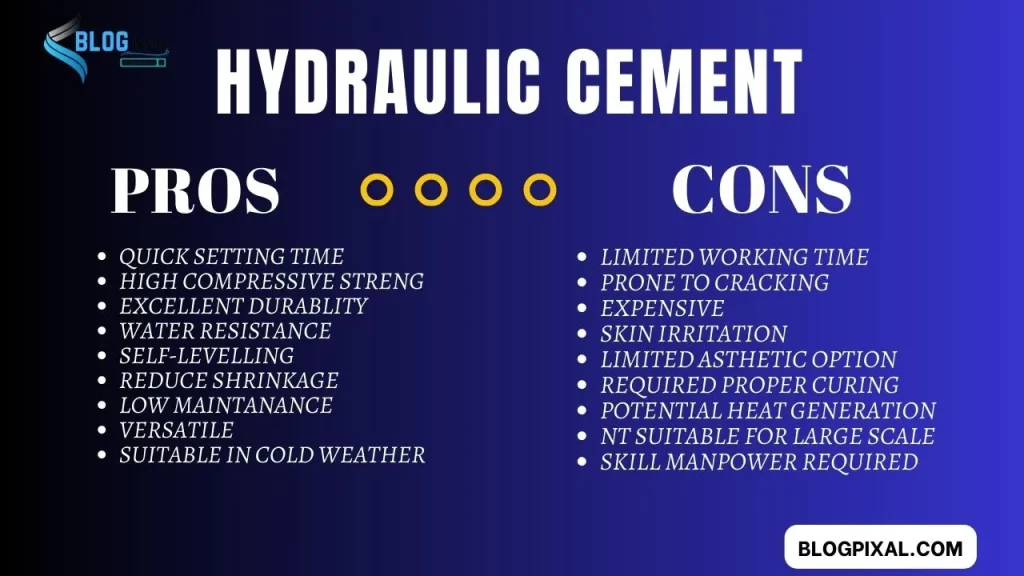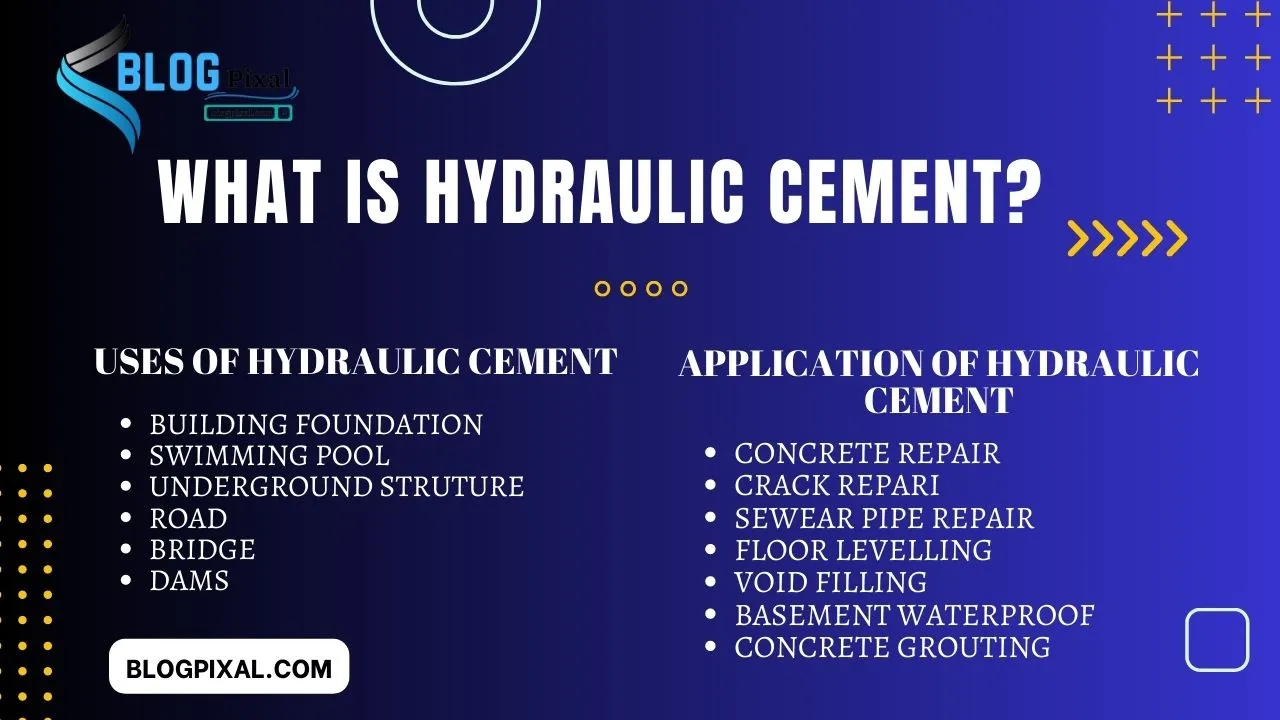Hi, Welcome to the next blog post. Today We will discuss One of the best Cement types used for many purposes. Do you know what is Hydraulic cement and how to use this material?
Hydraulic cement is a widely used construction material. In the modern infrastructure project mostly use this cement for better results.
It has a unique property compared to normal cement(non-hydraulic cement). The main property is faster setting and gives hardening strength through chemical reaction with water.
If you know any more including from this article please write in the comment section. In this post, we will explore the composition, pros and cons, uses, and application techniques and safety precuations of Hydraulic cement. Without wasting time let’s jump into the main topic:
What is Hydraulic Cement?
Hydraulic cement is a type of cement that mix with water gets Solidifies and becomes hard Properties. It is called Hydraulic because cement gains compressive strength through the Hydration process. By the Hydraulic cement particle combine with water to form stable crystalline compound.
If the hydraulic cement mix with the water that form a water resistance product. Basically, this product is used for 100 % waterproofing in the foundation and Underground level. The process of hydration of the Hydraulic cement produces hard solid mass.
This is one of the best waterproofing Cement to prevent water leakage from the Masonry and concrete structure. Like Brick wall share wall, Foundation Beam, and foundation pillar.
Mostly this cement is used for pressure grouting at Foundation and Underground where high water produces an effect on the structure.
Chemicals composition
Alite (3CaCo.SiO2)
Blite (2CaO.SiO2)
Tricalcium Aluminite
Brownmillerite (4CaO.AI2OFe2O3)
You must know about it-informative video
Components of Hydraulic Cement
Basically, Hydraulic cement is composed of four components: Gypsum, Portland Clinker, Pozzolanic, and Limestone. The Different Components have different properties mentioned below:
| Gypsum | Regulate Setting time by Slowing down the hydration process |
| Portland clinker | Primary binding agent |
| Pozzolanic(fly ash & Silica fume) | Improvement of cement properties and contribute to its long terms strength. |
| Limestone | Acts as a flux to facilitate the formation of liquid during clinker burning |
Role of water in the process
The water starts the hydration process in hydraulic cement and continues complex chemical reactions. In the Process of Hydration, cement particles react with water molecules to form calcium silicate hydrate and calcium hydroxide. The Calcium silicate hydrate gives the strength and durability of the cement.
Hydraulic Cement use
Following are the uses of hydraulic cement to improve strength, durability and water resistance from the seepage issues :
- Building Foundation
- Underground structure
- Swimming Pools and ponds
- Sanitation and Drainage systems
- Waterproof at the Masonry and Concrete Structure
- Manhole pits
- Chimney
- marines Application
- Repair concrete structures
- Tunnels subway system
- Bridge and infrastructure
- Airport Runways
- Retaining Walls -(Visit: techmeengineer)
- Oil and Gas industry
- Irrigation system
- Waterproofing basement
Advantages of Hydraulic cement
The followings are the major advantages of Hydraulic Cement mentioned in details:
High Compressive strength

Basically, cement is a Compressive material used for the different compression members. It has exceptional compressive strength. If we provide proper curing for the hydration process gets better strength and withstands loads, pressure, and ideal supporting of heavy structures.
Excellent Durability
It has another major advantage of use. It has excellent durability and long terms performance. The cement is properly work in different environmental conditions and give long run better performance without losing any strengths. It resist deterioration from moisture, chemical and abrasion to improving the long-life of contracted element.
Resistance to Chemical Attack
The cement protects from various chemical attacks due to the chemical stability of it. This is included sulfates and acids help to further to improving suitability for different applications. Mainly the property of hydraulic cement helps to increase quality of the result.
Versatile in applications
They have different application of the construction project. Such as Buildings, Bridges, roads, Dams and Underground structure. It is a High Demand construction materials choice for engineer and architecture worldwide due to its versatility in different application.
- It can be use for durable structural components
- It can be use for vertical component of structure.
- The cement is not corrosive and non rustable by the moisture.
- This can be settings within 1 hour.
Pros and cons of Hydraulic cement

I have mentioned the pros and cons of this cement in the table. Please review and comment for any suggestions:
| Pros of Hydraulic cement | Cons of Hydraulic cement |
| 1. Quick Setting Time | 1. Limited Working Time |
| 2. High Compressive Strength | 2. Prone to Cracking |
| 3. Excellent Durability | 3. Expensive |
| 4. Water-Resistant | 4. Can Cause Skin Irritation |
| 5. Suitable for Underwater Repairs | 5. Not Environmentally Friendly |
| 6. Self-Leveling Ability | 6. Limited Aesthetic Options |
| 7. Excellent Bonding | 7. Not Suitable for Thin Applications |
| 8. Reduced Shrinkage | 8. Requires Proper Curing |
| 9. Resists Chemical Attacks | 9. Potential Heat Generation |
| 10. Versatile Applications | 10. Initial Expansion during Setting |
| 11. Creates Watertight Seals | 11. Not Ideal for High-Temperature Areas |
| 12. Low Maintenance | 12. Not Suitable for Large-Scale Projects |
| 13. Long Shelf Life | 13. Not as Strong as Some Other Cement Types |
| 14. Decreases Permeability | 14. Demands Skilled Application |
| 15. Improves Concrete Strength | 15. May Require Special Equipment for Mixing |
| 16. Suitable for Cold Weather | 16. Potential for Efflorescence |
| 17. Offers High Sulfate Resistance | 17. May Crumble Over Time |
| 18. Can Patch Concrete | 18. Limited Availability in Remote Areas |
| 19. Reduces Corrosion Risk | 19. Some Varieties Release Harmful Chemicals |
| 20. Provides Rapid Repairs | 20. Not Advisable for DIY Projects |
Process of Application of Hydraulic Cement
- Surface Preparation:
- Clean the area to be repaired by removing any loose debris, dust, or contaminants.
- Saturate the surface with clean water before applying the hydraulic cement.
- Mixing:
- Follow the manufacturer’s instructions for mixing the hydraulic cement.
- Typically, you’ll need to add water to the dry cement mix and blend until you achieve a smooth, lump-free consistency.
- Application:
- Use a trowel or putty knife to apply the mixed hydraulic cement onto the prepared surface.
- Press the cement firmly into any cracks or voids, ensuring complete coverage.
- Leveling:
- The hydraulic cement is self-leveling it will automatically spread and settle into a flat surface.
- Otherwise, use the trowel to level the applied cement and create a smooth finish.
- Curing:
- Allow the hydraulic cement to cure as per the manufacturer’s recommendations.
- Keep the repaired area damp during the curing process by misting it with water regularly.
- Finishing (Optional):
- After the cement has partially cured, you may use a finishing trowel or sponge to smoothen the surface for a more polished look.
- Protection:
- Protect the freshly applied hydraulic cement from direct sunlight, rain, or extreme temperatures during the curing period.
- Secondary Coat (Optional):
- You can apply a second coat of hydraulic cement after the initial layer is fully cured for adding durability and a thick layer.
- Clean-Up:
- Clean your tools and equipment immediately after use to prevent the cement from hardening on Machine.
- Inspect and Maintain:
- After the hydraulic cement has fully cured inspect the repaired area for any imperfections or cracks.
- Perform regular maintenance to ensure the longevity of the repair and prevent future damage.
Common Uses of Hydraulic Cement
| Concrete Repairs | It is frequently used to repair cracks, holes, and damaged concrete surfaces. like buildings, roads, bridges, and other structures. Its quick setting time allows for rapid repairs. |
| Foundation Repair | It is employed to fix cracks and leaks in building foundations, providing a watertight seal and preventing further water infiltration. |
| Underwater Construction | This cement quickly sets and hardens even when submerged in water, making it ideal for underwater construction and repair work, such as dams, bridges, and underwater tunnels. |
| Sewer Pipe Repairs | The water resistance of hydraulic cement makes it suitable for sealing and rehabilitating sewer pipes, preventing leaks and enhancing pipe longevity. |
| Anchoring Objects | It is used to anchor bolts, posts, and other objects in concrete, ensuring a secure and reliable connection. |
| Floor Leveling | The cement’s self-leveling ability makes it useful for leveling uneven or sloping floors before installing new flooring materials. |
| Void Filling | It is employed to fill voids, cavities, and gaps in concrete structures, ensuring structural integrity and preventing water penetration. |
| Concrete Block Construction | It is commonly used in masonry and block construction to bind together blocks or bricks, creating strong and durable walls. |
| Basement Waterproofing | This is an essential component in basement waterproofing systems. When It applies to the basement it works as a waterproof barrier to prevent water seepage. |
| Concrete Grouting | It is utilized for grouting applications to fill gaps and voids in precast concrete elements, providing added strength and stability. |
| Road and Bridge Construction | Hydraulic cement is a fundamental component in building roads, highways, and bridges, ensuring long-lasting and sturdy infrastructure. |
| Concrete Pumping | It is compatible with concrete pumping equipment, enabling efficient and precise placement of concrete in large-scale projects. |
| Crack Injection | Hydraulic cement is used for crack injection to repair and seal cracks in concrete structures, preventing water intrusion and reinforcing the affected areas. |
| Emergency Repairs | Due to its rapid setting capabilities, hydraulic cement is ideal for emergency repairs in critical infrastructure or structures. |
| Reservoir and Tank Construction | It is employed in constructing water reservoirs, storage tanks, and retention structures due to its water-resistant properties. |
Comparison
Hydraulic cement vs Ordinary Portland cement
| Property | Hydraulic Cement | Ordinary Portland Cement (OPC) |
|---|---|---|
| Setting Time | Rapid setting, cures quickly | Standard setting time, requires longer curing time |
| Water Resistance | Highly water-resistant | Less water-resistant, may deteriorate in wet conditions |
| Applications | Suitable for underwater or damp environments | General construction purposes |
| Strength Development | Gains strength rapidly | Gradual strength development over time |
| Special Additives | Contains additives to achieve rapid setting | Typically does not contain additional additives |
| Usage | Used in projects where quick setting is required | Commonly used in most construction projects |
| Types | Includes products like Rapid Hardening Cement | Types include OPC-33, OPC-43, OPC-53, etc. |

Hydraulic Cement Vs Rapid-Setting Cement
| Property | Hydraulic Cement | Rapid-Setting Cement |
|---|---|---|
| Setting Time | Slow setting time | Rapid setting time |
| Curing Time | Requires longer curing time | Shorter curing time |
| Use | Ideal for large construction projects and structures | Suitable for quick repairs and small projects |
| Composition | Contains Portland cement and supplementary cementitious materials | Contains high amounts of C3A (tricalcium aluminate) for quick setting |
| Strength Development | Gains strength over time | Develops high early strength quickly |
| Workability | Generally has good workability | May have lower workability due to quick setting |
| Application | Bridges, dams, large buildings, and structures | Patching, anchoring, and minor repairs |
| Waterproofing | Good waterproofing properties | May have slightly reduced waterproofing characteristics |
| Environmental Impact | Usually has a lower environmental impact due to slow curing process | Environmental impact depends on the specific formulation |
Safety Measure and Environmental Impact
- Personal Protective Equipment (PPE): When handling hydraulic cement, workers should wear appropriate PPE, including safety goggles, gloves, and a dust mask or respirator to protect against dust breathing and skin contact.
- Ventilation: Adequate ventilation should be provided in areas where hydraulic cement is used or mixed to minimize dust buildup and breathing risks.
- Handling and Storage: Workers should be trained in proper handling and storage procedures to prevent injuries and minimize the risk of accidents.
- Avoiding Contact with Skin and Eyes: Hydraulic cement is alkaline and can cause irritation or burns. In case of contact, affected areas should be rinsed thoroughly with water and medical attention sought if necessary.
- Preventing Inhalation: Workers should avoid breathing in dust by using dust collection systems or wearing masks.
- Emergency Preparedness: First aid facilities should be readily available on-site, and workers should be trained to respond to emergencies involving hydraulic cement.
Environmental Impact of this Cement:
- Carbon Emissions: The production of hydraulic cement, especially Portland cement, is associated with significant carbon dioxide (CO2) emissions. The calcination process, which involves heating limestone to produce clinker, releases CO2 as a byproduct.
- Energy Consumption: The manufacturing process of hydraulic cement requires substantial energy input, contributing to overall energy consumption and environmental impact.
- Water Consumption: Cement production consumes large amounts of water, both for cooling purposes and in the cement hydration process.
- Land Use and Habitat Disruption: Quarrying of raw materials for cement production can lead to habitat disruption and affect local ecosystems.
- Waste Generation: Cement production generates waste materials, including dust, sludge, and kiln ash, which require proper management and disposal to minimize environmental impact.
- Water Pollution: Improper handling and storage of cement can lead to water pollution if the material leaches into nearby water bodies, increasing the water’s pH levels and affecting aquatic life.
Conclusions
Hydraulic Cement has revolutionized the construction industry with advance properties and different applications. It has high strength, quick set and harden process by the hydrations. It is highly recommended by the engineers and architecture in the construction project in worldwide. It is essential to handle hydraulic cement with care and consider its environmental impact to ensure a sustainable future.
FAQs
Can hydraulic cement be used for underwater repairs?
Yes, hydraulic cement can be used for underwater repairs, making it an ideal choice for marine construction.
How long does it take for hydraulic cement to cure completely?
The curing time for hydraulic cement varies depending on factors such as temperature and humidity, but it generally takes several days to reach full strength.
Is hydraulic Power suitable for high-temperature applications?
Yes, hydraulic cement exhibits excellent performance in high-temperature conditions, making it suitable for a wide range of applications.
Can this cement be colored to match specific aesthetics?
Yes, hydraulic cement can be mixed with pigments to achieve desired colors, making it versatile in decorative applications.
Does cement contribute to sustainable construction practices?
Yes, hydraulic cement manufacturers are increasingly adopting sustainable practices and incorporating recycled materials to reduce their environmental impact and promote sustainability.
Also Read
Top 25 Powerful Civil Engineering Apps Free Download
Step by step Guide to Preparing Room Wall for Painting in 2023
How to Download and Install WhatsApp on macOS for Free?
The Ultimate Guide to the Top 10 Professional Photography Apps of 2023
What is TikTok? Easy Step to Repost on TikTok and undo Repost on TikTok in 2023.
How to Avoid Flood Damage in New Construction Project [10 Best Practical Solution]
The Ultimate Guide to Concrete Spalling: 4 Causes, effect, Repair, and Maintenance
What is Juliet Balcony? The Best Ultimate Guide of Juliet Balconies [5 Types]










